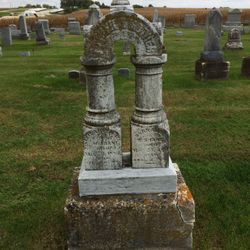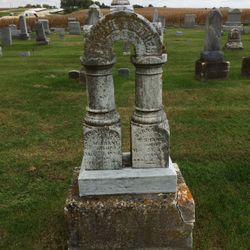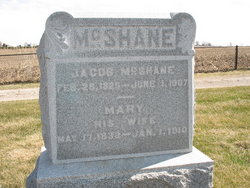| Description |
: |
From: Portrait and Biographical Record of the State of Colorado, 1899
DAVID MCSHANE. The pioneers of '60 have a worthy representative in this well-known citizen of Colorado Springs. Mr. McShane came to the mountain regions in early days, thoroughly imbued with the spirit of western enterprise and push. Dangers did not daunt him, nor hardships discourage. It has been his privilege to witness the growth of Colorado from a territory with a small population, almost wholly miners, to a state that ranks in population and influence among the greatest of the states west of the Mississippi Valley. To this development and...
Read More
|
From: Portrait and Biographical Record of the State of Colorado, 1899
DAVID MCSHANE. The pioneers of '60 have a worthy representative in this well-known citizen of Colorado Springs. Mr. McShane came to the mountain regions in early days, thoroughly imbued with the spirit of western enterprise and push. Dangers did not daunt him, nor hardships discourage. It has been his privilege to witness the growth of Colorado from a territory with a small population, almost wholly miners, to a state that ranks in population and influence among the greatest of the states west of the Mississippi Valley. To this development and progress he has himself been a large contributor.
As the name indicates, the McShane family is of Scotch descent. Daniel McShane, grandfather of David, was born in New Jersey, and became a pioneer farmer of Fayette County, Pa. He had a brother, Robert, who settled in Monongahela County, Va. , and served through the Revolutionary war, afterwards resuming farm work; such was his physical vigor that he walked fifteen, miles on the day before he died, when ninety-four years of age. Daniel removed to Iowa in 1850 and died there at seventy-eight years of age.
Our subject's father, Barney McShane, was born in Fayette County, Pa., and for twenty-five years engaged in dealing in horses, which he sold in Baltimore and Washington, D. C. The national road passed through Fayette County, where he resided, and formed the principal thoroughfare between Baltimore and Wheeling. In 1852 he moved to Linn County, Iowa, and settled upon a farm near Marion. There he died at eighty-one years. His wife was Elizabeth Romine, a native of Loudoun County, Va., and of
Scotch descent. In girlhood she removed with her parents to Pennsylvania, and there married; afterward her parents went to Ohio. At the time of her death she was eighty-five years of age. In her family there were nine sons and four daughters, of whom eight sons and one daughter attained mature years. The eldest of the family, Francis, served through the Civil war as a member of the Eleventh Kansas Infantry, and died in Linn County, Kan., at seventy-three years of age. Luther, who died in California, was a lieutenant in the Ninth Iowa Infantry during the Civil War and took part in thirteen battles without receiving a wound. Jacob is living in Linn County, Iowa. William formerly of Fayette County, Pa., is now deceased. David, of this sketch, was next in order of birth. John C., who came to Colorado in 1 860, is a wholesale and retail grocer in Central City, Gilpin County, Colo. Thomas Porter died at Helena, Ark., while serving in the Twenty-fourth Iowa Infantry. Mrs. Eliza J. Horace died in Iowa; a daughter died in childhood; Daniel was drowned in Pennsylvania when a boy; and Ashbel died there when ten years of age.
Nine miles south of Uniontown, Pa., the subject of this sketch was born October 3, 1830. In boyhood he assisted in operating a small coal mine, with a fine coal vein, that was on the home farm. In the fall of 1851 he went to Linn County, Iowa, where he improved a farm from raw prairie. Four years later he traveled further westward, by team, and settled at Manhattan, Kan., where he assisted in building the first house. He took up land, but after three months went back to Iowa and resumed farming. In 1860, with his brothers, Francis and John C., he started to Colorado. They outfitted ox-trains at Kansas City, from which point John C. went up the Platte to Central City, and the others went to Summit County. May 6, 1860, Francis and David took dinner at Manitou, which at that time had only one building, a small log cabin, put up by Dick Woolen. They crossed the mountain at the base of Pike's Peak and went down on the other side to the Fountain Quibouille ("River that Boils"), which they followed to the head, striking across to the head waters of the Platte, thence to Blue River and Breckenridge. Theirs was the first train that crossed the range to Summit. For four years they engaged in placer mining on Humbug and American Gulch. Meantime, in the fall of 1860, our subject went to the San Juan country, with the first party that entered there. The winter was cold and the snow deep, and when spring rendered possible their retreat from San Juan, they hastened back to Breckenridge.
In the fall of 1864, with ox-teams, Mr. McShane returned to Iowa, and in the spring of 1865 returned via the Platte. At that time Indians were exceedingly troublesome, but he fortunately was not attacked. In the spring of 1865 he took up one hundred and sixty acres three miles south of Palmer Lake. Two years later he returned to Iowa and brought the family west, settling on the ranch, where he engaged in the dairy and cattle business. He still owns the property, comprising three hundred and twenty acres, with suitable buildings, irrigation facilities and other improvements. In the summer of 1868 the Cheyenne and Arapahoe Indians made a raid through the country and killed several people in his neighborhood, besides driving horses and cattle away. At the time he was away from home, and on his return found that his horses had been taken, but his wife, with true frontier pluck, had frightened twenty-three Indians off with her gun, so that the family were safe. Realizing the great danger of another attack, he at once built, near his house, a stone round house, with port holes. From the house to the fort he built an underground passage, so that the family might escape, unseen by the Indians. This building still stands and is one of the few remaining relics of pioneer days. He continued in the cattle business and also raised fine horses, residing on the ranch until 1888, when he removed to Colorado Springs, leaving his son to operate the ranch.
For some years Mr. McShane has been a contractor in the building of railroads and reservoirs. He contracted for eight miles of the Colorado Midland, from the vicinity of Cascade to Woodland Park, along the same road that he traveled in 1860; also had contracts on the Union Pacific, Denver & Gulf, and other railroads, and built ten reservoirs in El Paso County. During all these years he has been more or less interested in mining, and at one time was president of the Bison Mining and Milling Company at Cripple Creek, he having discovered and developed the Bison mine. He now owns valuable property in Summit County, where he first mined.
In Iowa Mr. McShane married Miss Catherine Willyard, daughter of Allen Willyard, and a native of Fayette County, Pa. She was a woman of brave, noble character, admirably fitted for the arduous task of rearing a family on the frontier. She died April 10, 1898, of paralysis. The seven children born of their marriage are: Laura, Mrs. George Mewbrough, of Monument; Mary, wife of Alexander Perrault, of Minnesota; Albert, who cultivates his father's ranch; Sarah, wife of Frank Cotton, of Colorado Springs; Delia, Lucy and William, at home.
Politically a Democrat, Mr. McShane has been a delegate to the various territorial and state conventions. In 1869 he was elected county commissioner, overcoming a large Republican majority. In 1872 he was re-elected, serving until January, 1876. Again, in 1883, he was elected commissioner and served for three years. During much of the time since he has made his home in El Paso County, he has been a school director. He assisted in building the first school house in Monument, and afterward helped to erect two others. He is a member of the El Paso County Pioneers' Association and the Association of Colorado Pioneers. While in Breckenridge he was made a Mason. He is a charter member of El Paso Lodge No. 13. He was made a Chapter Mason in Colorado Springs Lodge No. 12, R. A. M. He is also identified with Pike's Peak Commandery No. 6, K.T. , and belongs to El Jebel Temple, N.M.S., of Denver.
In taking a retrospective view of the life of Mr. McShane we find a man who started out for himself with but little. However, he had a good constitution, with great power of endurance; and this, with his energy and determination, enabled him to succeed where another of less force of character might have failed. In the midst of private duties he has never neglected the duties of a citizen, but has always shown an intelligent interest in public affairs, and has never considered his personal interests when the prosperity of his city or state is involved.
____________________________________________________________
From: The Real Pioneers of Colorado, Vol. 2, Page 381
DAVID McSHANE
David McShane was born October 3, 1830, 9 miles south of Uniontown, Pennsylvania, a son of Barney McShane [who was] born in Fayette County, Pennsylvania, and Elizabeth Romine, a native of Loudoun County, Virginia. Like her husband, she was of Scottish descent.
They were the parents of nine sons and four daughters, of whom eight sons and one daughter attained mature years.
The eldest of the family, Francis, served through the Civil War as a member of the 11th Kansas Infantry and died in Linn County, Kansas, at 73 years of age.
Luther, who died in California, was a lieutenant in the 9th Iowa Infantry during the Civil War and took part in 13 battles without receiving a wound.
Jacob lived in Linn County, Iowa. William is now deceased. David was next in order of birth. John C., who came to Colorado in 1860, is a retail and wholesale grocer in Central City, Gilpin County. Thomas Porter died at Helena, Arkansas, while serving in the 24th Iowa Infantry. Mrs. Eliza J. Horace died in Iowa. A daughter died in childhood. Daniel was drowned in Pennsylvania when a boy, and Ashbel died there when 10 years of age.
David, in boyhood, assisted in operating a small coal mine with a fine coal vein. That was on the home farm. In the fall of 1851 he went to Linn County, Iowa, where he improved a farm from raw prairie. Four years later he traveled further westward by team and settled at Manhattan, Kansas, where he assisted in building the first house.
In 1860, with his brothers Francis and John C., he started for Colorado. They outfitted ox trains at Kansas City from which point John C. went up the Platte to Central City and the others went to Summit County. On May 6, 1860, Francis and David took dinner at Manitou, which at that time, had only one building, a small log cabin put up by Dick Wooten.
They crossed the mountain at the base of Pikes Peak and went down on the other side to the Fountain Quibouilei [La Fountaine qui Bouille] (“River that boils”), which they followed to the head, striking across to the head waters of the Platte. Thence to Blue River and Breckenridge.
Theirs was the first “train” that crossed the range to Summit. For 4 years they engaged in placer mining on Humbug and American Gulch. Meantime, in the fall of 1860, they went to the San Juan country with the first party that entered there. The winter was cold and the snow deep and when spring rendered possible their retreat from San Juan they hastened back to Breckenridge.
In the fall of 1864 with ox teams, Mr. McShane returned to Iowa and in the spring of 1865 returned via the Platte. At the time, Indians were exceedingly troublesome, but he fortunately was not attacked.
In the spring of 1865 he took up 160 acres, 3 miles south of Palmer Lake. Two years later he returned to Iowa and brought the family West, settling on the ranch where he engaged in the dairy and cattle business.
In the summer of 1868, the Cheyenne and Arapahoe Indians made a raid through the country and killed several people in his neighborhood, besides driving horses and cattle away. At the time, he was away from home and on his return found that his horses had been taken, but his wife, with true frontier pluck, had frightened 23 Indians off with her gun, so that the family were safe. Realizing the great danger of another attack, he at once built near his house a stone round house with port holes. From the house to the fort he built an underground passage so that the family might escape unseen by the Indians. This building still stands and is one of the few remaining relics of pioneer days.
He continued in the cattle business and also raised fine horses, residing on the ranch until 1888 when he removed to Colorado Springs, leaving his son to operate the ranch.
For some years Mr. McShane has been a contractor in the building of railroads and reservoirs. He contracted for 8 miles of the Colorado Midland from the vicinity of Cascade to Woodland Park along the same road that he traveled in 1860.
He also had contracts on the Union Pacific, Denver and Gulf, and other railroads, and built ten reservoirs in El Paso County. He was also interested in mining. At one time he was president of the Bison Mining and Milling Company at Cripple Creek, he having discovered and developed the Bison Mine. He owns valuable property in Summit County where he first mined.
In Iowa Mr. McShane married Miss Catherine Willyard, daughter of Allen Willyard, a native of Fayette County, Pennsylvania. She died April 10, 1898, of paralysis. They were the parents of seven children: Laura, Mrs. George Newbrough of Monument; Mary, wife of Alexander Perrault of Minnesota; Albert, who cultivated his father’s ranch; Sarah, wife of Frank Cotton of Colorado Springs; Della; Lucy and William at home.
He assisted in building the first school building in Monument and afterward helped to erect two others and served as school director much of his time. He is a member of the El Paso County Pioneer Association and the Association of Colorado Pioneers.
Mr. McShane died at Colorado Springs May 17, 1907.
|




